Reflective Report: Counselling Session Analysis - Psychology
VerifiedAdded on 2022/10/01
|7
|2336
|461
Report
AI Summary
This report presents an in-depth analysis of a counselling session, focusing on the application of Egan's Skilled Helper Solution Focused Counselling Approach. The student analyzes their performance, highlighting the use of micro skills, such as active listening, attending behavior, and questioning, as well as the demonstration of empathy and accurate responding. The report evaluates the session's structure, including the initial ice breaker, establishing confidentiality, and the use of open-ended questions to explore the client's issues. The student identifies strengths, such as effective listening skills, SOLER techniques, and reflective responses, while also acknowledging areas for improvement, including body language and empathetic understanding. The report concludes with a reflection on the skills required for effective counselling, the student's areas of competence, and the need for continuous development in areas such as non-verbal communication and emotional responsiveness. The student uses references to support the analysis of the session.

ASSESSMENT COVER SHEET
Family Name: Given Name(s):
Student ID: Course:
Unit Code: Unit Name:
Lecturer: Assessment Number/Title:
Semester/Trimester and Year: Word Count:
Student’s Declaration of Authorship
I certify that this assessment is my original work. No part of it has been submitted for another
assessment/unit/course, except where permitted by the lecturer/department.
I have not copied any part of it from another source or other students’ work, except where I
have properly acknowledged it in this assessment.
I have not participated in any unauthorised collaboration in completing this assessment,
including paying/arranging for another person to complete it in part or in full.
I have done my due diligence to ensure that my assessment cannot be copied by other people.
I understand that my assessment may be reproduced to submit to plagiarism detection
programs, which may retain a copy to assist in future plagiarism checking.
I have retained a copy of this assessment and would be able to produce it, if required.
I understand that it is my responsibility to become familiar with the college’s Academic
Misconduct Policy and Procedure found at
http://www.acknowledgeeducation.edu.au/policies-and-procedures/. I am aware that
committing academic offences, including plagiarism and collusion, may result in academic
penalties.
Family Name: Given Name(s):
Student ID: Course:
Unit Code: Unit Name:
Lecturer: Assessment Number/Title:
Semester/Trimester and Year: Word Count:
Student’s Declaration of Authorship
I certify that this assessment is my original work. No part of it has been submitted for another
assessment/unit/course, except where permitted by the lecturer/department.
I have not copied any part of it from another source or other students’ work, except where I
have properly acknowledged it in this assessment.
I have not participated in any unauthorised collaboration in completing this assessment,
including paying/arranging for another person to complete it in part or in full.
I have done my due diligence to ensure that my assessment cannot be copied by other people.
I understand that my assessment may be reproduced to submit to plagiarism detection
programs, which may retain a copy to assist in future plagiarism checking.
I have retained a copy of this assessment and would be able to produce it, if required.
I understand that it is my responsibility to become familiar with the college’s Academic
Misconduct Policy and Procedure found at
http://www.acknowledgeeducation.edu.au/policies-and-procedures/. I am aware that
committing academic offences, including plagiarism and collusion, may result in academic
penalties.
Paraphrase This Document
Need a fresh take? Get an instant paraphrase of this document with our AI Paraphraser
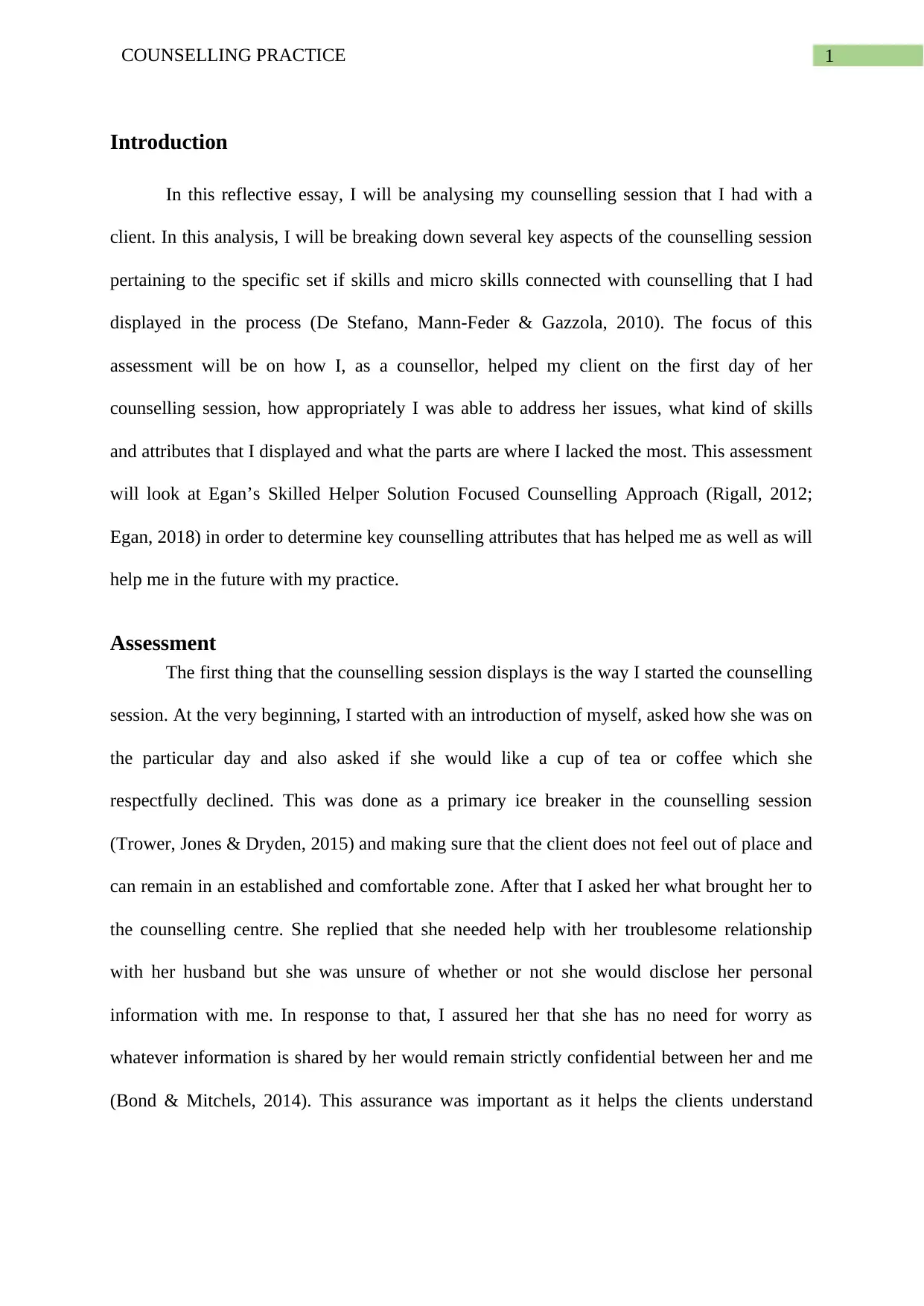
1COUNSELLING PRACTICE
Introduction
In this reflective essay, I will be analysing my counselling session that I had with a
client. In this analysis, I will be breaking down several key aspects of the counselling session
pertaining to the specific set if skills and micro skills connected with counselling that I had
displayed in the process (De Stefano, Mann-Feder & Gazzola, 2010). The focus of this
assessment will be on how I, as a counsellor, helped my client on the first day of her
counselling session, how appropriately I was able to address her issues, what kind of skills
and attributes that I displayed and what the parts are where I lacked the most. This assessment
will look at Egan’s Skilled Helper Solution Focused Counselling Approach (Rigall, 2012;
Egan, 2018) in order to determine key counselling attributes that has helped me as well as will
help me in the future with my practice.
Assessment
The first thing that the counselling session displays is the way I started the counselling
session. At the very beginning, I started with an introduction of myself, asked how she was on
the particular day and also asked if she would like a cup of tea or coffee which she
respectfully declined. This was done as a primary ice breaker in the counselling session
(Trower, Jones & Dryden, 2015) and making sure that the client does not feel out of place and
can remain in an established and comfortable zone. After that I asked her what brought her to
the counselling centre. She replied that she needed help with her troublesome relationship
with her husband but she was unsure of whether or not she would disclose her personal
information with me. In response to that, I assured her that she has no need for worry as
whatever information is shared by her would remain strictly confidential between her and me
(Bond & Mitchels, 2014). This assurance was important as it helps the clients understand
Introduction
In this reflective essay, I will be analysing my counselling session that I had with a
client. In this analysis, I will be breaking down several key aspects of the counselling session
pertaining to the specific set if skills and micro skills connected with counselling that I had
displayed in the process (De Stefano, Mann-Feder & Gazzola, 2010). The focus of this
assessment will be on how I, as a counsellor, helped my client on the first day of her
counselling session, how appropriately I was able to address her issues, what kind of skills
and attributes that I displayed and what the parts are where I lacked the most. This assessment
will look at Egan’s Skilled Helper Solution Focused Counselling Approach (Rigall, 2012;
Egan, 2018) in order to determine key counselling attributes that has helped me as well as will
help me in the future with my practice.
Assessment
The first thing that the counselling session displays is the way I started the counselling
session. At the very beginning, I started with an introduction of myself, asked how she was on
the particular day and also asked if she would like a cup of tea or coffee which she
respectfully declined. This was done as a primary ice breaker in the counselling session
(Trower, Jones & Dryden, 2015) and making sure that the client does not feel out of place and
can remain in an established and comfortable zone. After that I asked her what brought her to
the counselling centre. She replied that she needed help with her troublesome relationship
with her husband but she was unsure of whether or not she would disclose her personal
information with me. In response to that, I assured her that she has no need for worry as
whatever information is shared by her would remain strictly confidential between her and me
(Bond & Mitchels, 2014). This assurance was important as it helps the clients understand
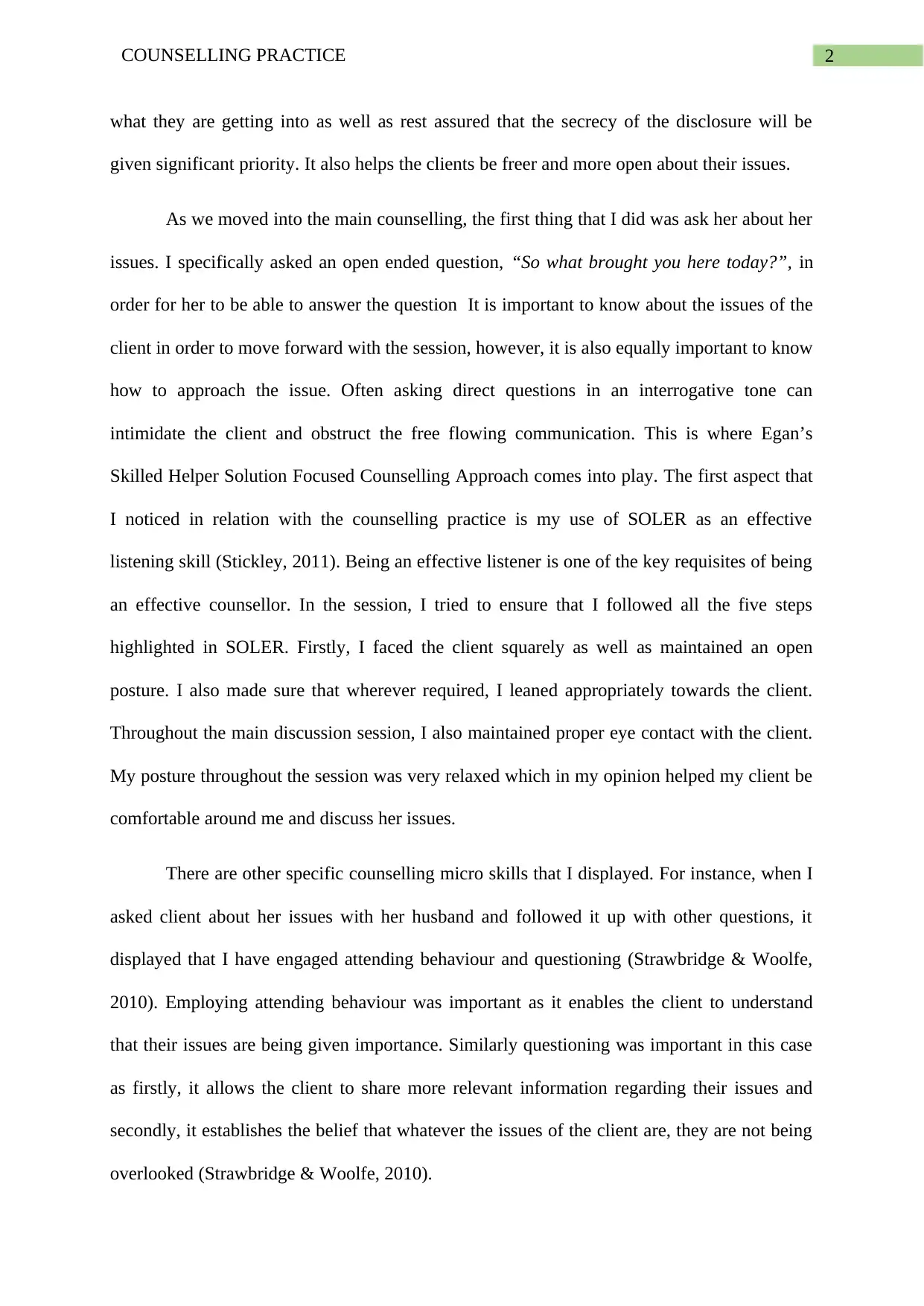
2COUNSELLING PRACTICE
what they are getting into as well as rest assured that the secrecy of the disclosure will be
given significant priority. It also helps the clients be freer and more open about their issues.
As we moved into the main counselling, the first thing that I did was ask her about her
issues. I specifically asked an open ended question, “So what brought you here today?”, in
order for her to be able to answer the question It is important to know about the issues of the
client in order to move forward with the session, however, it is also equally important to know
how to approach the issue. Often asking direct questions in an interrogative tone can
intimidate the client and obstruct the free flowing communication. This is where Egan’s
Skilled Helper Solution Focused Counselling Approach comes into play. The first aspect that
I noticed in relation with the counselling practice is my use of SOLER as an effective
listening skill (Stickley, 2011). Being an effective listener is one of the key requisites of being
an effective counsellor. In the session, I tried to ensure that I followed all the five steps
highlighted in SOLER. Firstly, I faced the client squarely as well as maintained an open
posture. I also made sure that wherever required, I leaned appropriately towards the client.
Throughout the main discussion session, I also maintained proper eye contact with the client.
My posture throughout the session was very relaxed which in my opinion helped my client be
comfortable around me and discuss her issues.
There are other specific counselling micro skills that I displayed. For instance, when I
asked client about her issues with her husband and followed it up with other questions, it
displayed that I have engaged attending behaviour and questioning (Strawbridge & Woolfe,
2010). Employing attending behaviour was important as it enables the client to understand
that their issues are being given importance. Similarly questioning was important in this case
as firstly, it allows the client to share more relevant information regarding their issues and
secondly, it establishes the belief that whatever the issues of the client are, they are not being
overlooked (Strawbridge & Woolfe, 2010).
what they are getting into as well as rest assured that the secrecy of the disclosure will be
given significant priority. It also helps the clients be freer and more open about their issues.
As we moved into the main counselling, the first thing that I did was ask her about her
issues. I specifically asked an open ended question, “So what brought you here today?”, in
order for her to be able to answer the question It is important to know about the issues of the
client in order to move forward with the session, however, it is also equally important to know
how to approach the issue. Often asking direct questions in an interrogative tone can
intimidate the client and obstruct the free flowing communication. This is where Egan’s
Skilled Helper Solution Focused Counselling Approach comes into play. The first aspect that
I noticed in relation with the counselling practice is my use of SOLER as an effective
listening skill (Stickley, 2011). Being an effective listener is one of the key requisites of being
an effective counsellor. In the session, I tried to ensure that I followed all the five steps
highlighted in SOLER. Firstly, I faced the client squarely as well as maintained an open
posture. I also made sure that wherever required, I leaned appropriately towards the client.
Throughout the main discussion session, I also maintained proper eye contact with the client.
My posture throughout the session was very relaxed which in my opinion helped my client be
comfortable around me and discuss her issues.
There are other specific counselling micro skills that I displayed. For instance, when I
asked client about her issues with her husband and followed it up with other questions, it
displayed that I have engaged attending behaviour and questioning (Strawbridge & Woolfe,
2010). Employing attending behaviour was important as it enables the client to understand
that their issues are being given importance. Similarly questioning was important in this case
as firstly, it allows the client to share more relevant information regarding their issues and
secondly, it establishes the belief that whatever the issues of the client are, they are not being
overlooked (Strawbridge & Woolfe, 2010).
⊘ This is a preview!⊘
Do you want full access?
Subscribe today to unlock all pages.

Trusted by 1+ million students worldwide
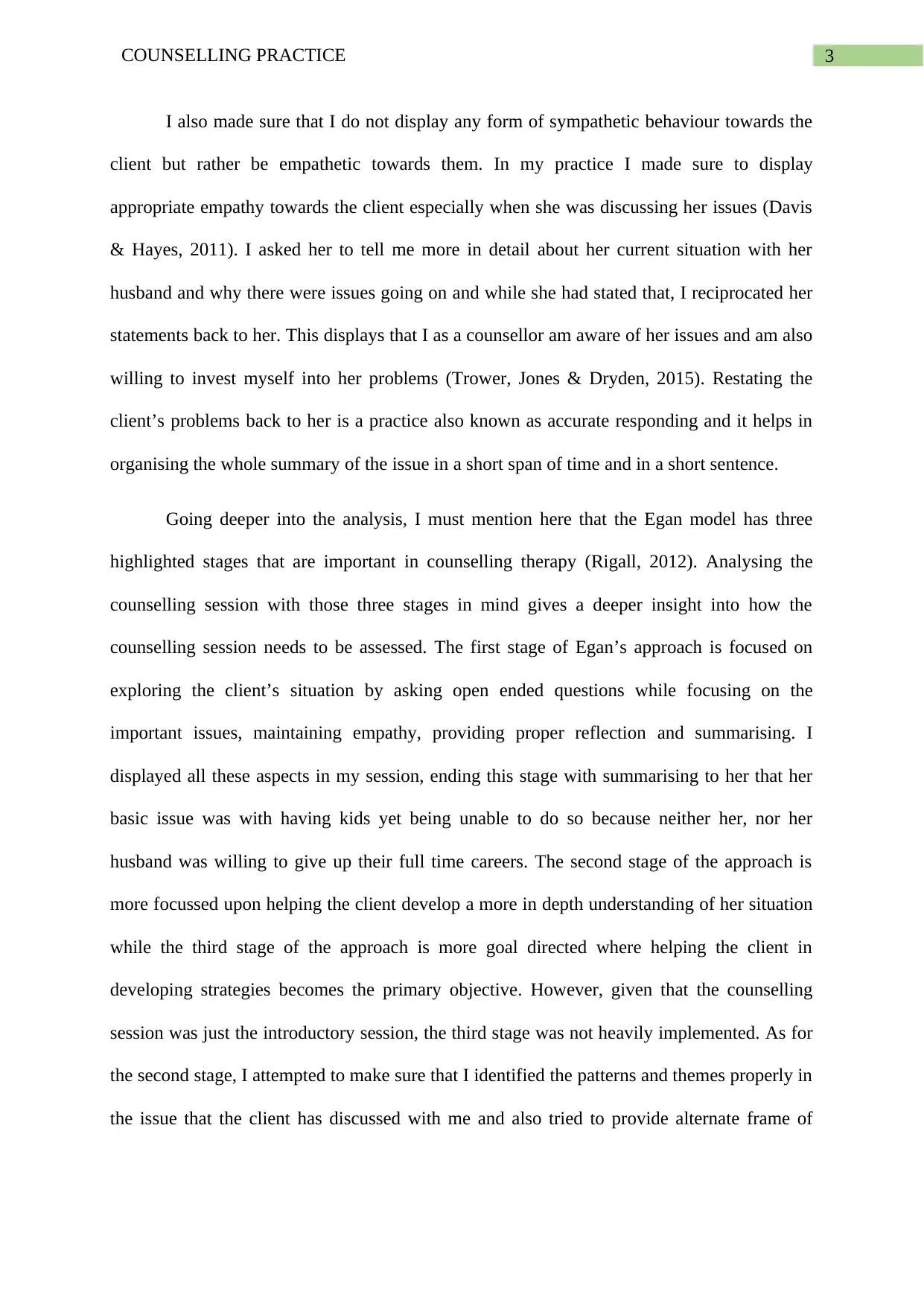
3COUNSELLING PRACTICE
I also made sure that I do not display any form of sympathetic behaviour towards the
client but rather be empathetic towards them. In my practice I made sure to display
appropriate empathy towards the client especially when she was discussing her issues (Davis
& Hayes, 2011). I asked her to tell me more in detail about her current situation with her
husband and why there were issues going on and while she had stated that, I reciprocated her
statements back to her. This displays that I as a counsellor am aware of her issues and am also
willing to invest myself into her problems (Trower, Jones & Dryden, 2015). Restating the
client’s problems back to her is a practice also known as accurate responding and it helps in
organising the whole summary of the issue in a short span of time and in a short sentence.
Going deeper into the analysis, I must mention here that the Egan model has three
highlighted stages that are important in counselling therapy (Rigall, 2012). Analysing the
counselling session with those three stages in mind gives a deeper insight into how the
counselling session needs to be assessed. The first stage of Egan’s approach is focused on
exploring the client’s situation by asking open ended questions while focusing on the
important issues, maintaining empathy, providing proper reflection and summarising. I
displayed all these aspects in my session, ending this stage with summarising to her that her
basic issue was with having kids yet being unable to do so because neither her, nor her
husband was willing to give up their full time careers. The second stage of the approach is
more focussed upon helping the client develop a more in depth understanding of her situation
while the third stage of the approach is more goal directed where helping the client in
developing strategies becomes the primary objective. However, given that the counselling
session was just the introductory session, the third stage was not heavily implemented. As for
the second stage, I attempted to make sure that I identified the patterns and themes properly in
the issue that the client has discussed with me and also tried to provide alternate frame of
I also made sure that I do not display any form of sympathetic behaviour towards the
client but rather be empathetic towards them. In my practice I made sure to display
appropriate empathy towards the client especially when she was discussing her issues (Davis
& Hayes, 2011). I asked her to tell me more in detail about her current situation with her
husband and why there were issues going on and while she had stated that, I reciprocated her
statements back to her. This displays that I as a counsellor am aware of her issues and am also
willing to invest myself into her problems (Trower, Jones & Dryden, 2015). Restating the
client’s problems back to her is a practice also known as accurate responding and it helps in
organising the whole summary of the issue in a short span of time and in a short sentence.
Going deeper into the analysis, I must mention here that the Egan model has three
highlighted stages that are important in counselling therapy (Rigall, 2012). Analysing the
counselling session with those three stages in mind gives a deeper insight into how the
counselling session needs to be assessed. The first stage of Egan’s approach is focused on
exploring the client’s situation by asking open ended questions while focusing on the
important issues, maintaining empathy, providing proper reflection and summarising. I
displayed all these aspects in my session, ending this stage with summarising to her that her
basic issue was with having kids yet being unable to do so because neither her, nor her
husband was willing to give up their full time careers. The second stage of the approach is
more focussed upon helping the client develop a more in depth understanding of her situation
while the third stage of the approach is more goal directed where helping the client in
developing strategies becomes the primary objective. However, given that the counselling
session was just the introductory session, the third stage was not heavily implemented. As for
the second stage, I attempted to make sure that I identified the patterns and themes properly in
the issue that the client has discussed with me and also tried to provide alternate frame of
Paraphrase This Document
Need a fresh take? Get an instant paraphrase of this document with our AI Paraphraser
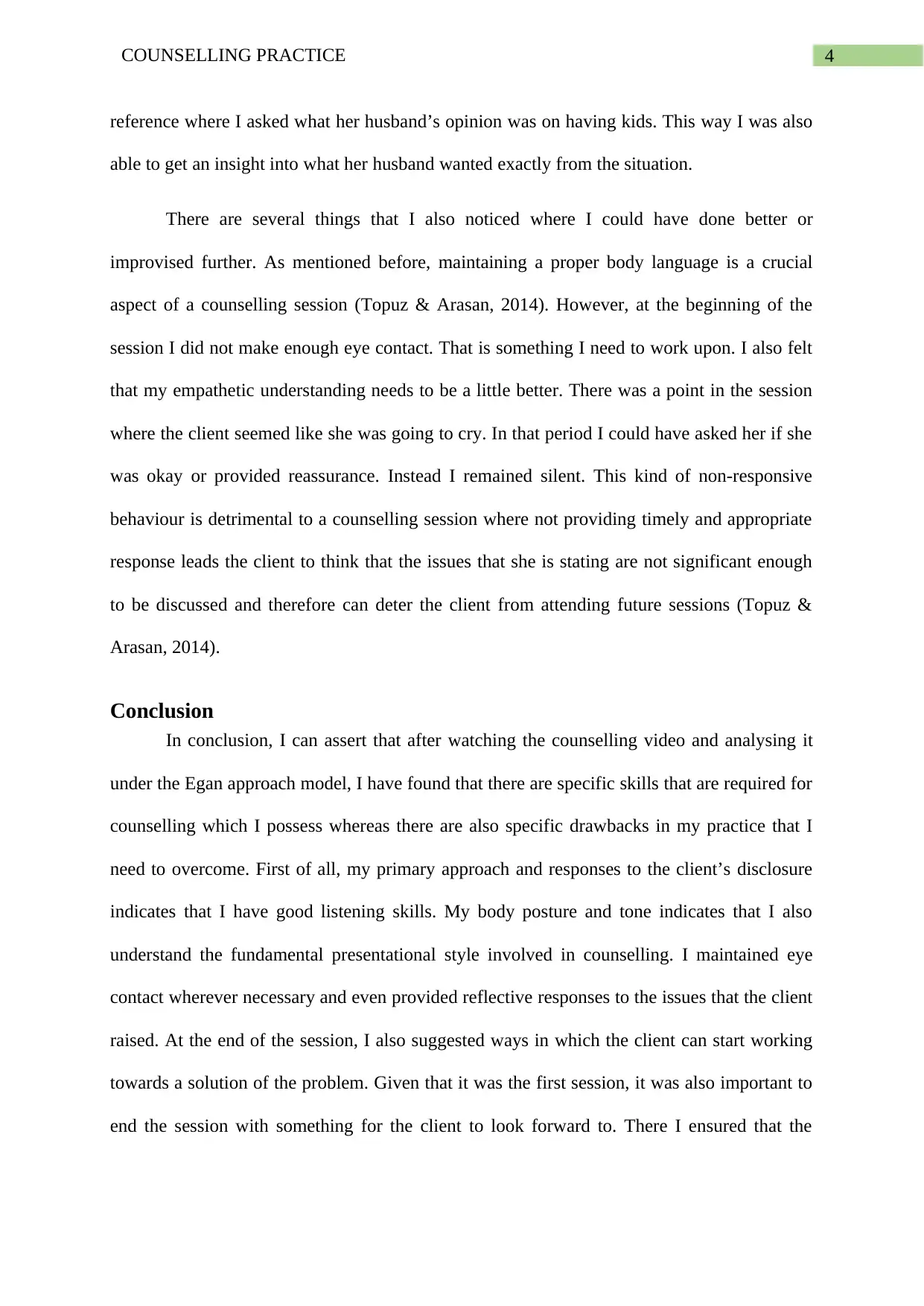
4COUNSELLING PRACTICE
reference where I asked what her husband’s opinion was on having kids. This way I was also
able to get an insight into what her husband wanted exactly from the situation.
There are several things that I also noticed where I could have done better or
improvised further. As mentioned before, maintaining a proper body language is a crucial
aspect of a counselling session (Topuz & Arasan, 2014). However, at the beginning of the
session I did not make enough eye contact. That is something I need to work upon. I also felt
that my empathetic understanding needs to be a little better. There was a point in the session
where the client seemed like she was going to cry. In that period I could have asked her if she
was okay or provided reassurance. Instead I remained silent. This kind of non-responsive
behaviour is detrimental to a counselling session where not providing timely and appropriate
response leads the client to think that the issues that she is stating are not significant enough
to be discussed and therefore can deter the client from attending future sessions (Topuz &
Arasan, 2014).
Conclusion
In conclusion, I can assert that after watching the counselling video and analysing it
under the Egan approach model, I have found that there are specific skills that are required for
counselling which I possess whereas there are also specific drawbacks in my practice that I
need to overcome. First of all, my primary approach and responses to the client’s disclosure
indicates that I have good listening skills. My body posture and tone indicates that I also
understand the fundamental presentational style involved in counselling. I maintained eye
contact wherever necessary and even provided reflective responses to the issues that the client
raised. At the end of the session, I also suggested ways in which the client can start working
towards a solution of the problem. Given that it was the first session, it was also important to
end the session with something for the client to look forward to. There I ensured that the
reference where I asked what her husband’s opinion was on having kids. This way I was also
able to get an insight into what her husband wanted exactly from the situation.
There are several things that I also noticed where I could have done better or
improvised further. As mentioned before, maintaining a proper body language is a crucial
aspect of a counselling session (Topuz & Arasan, 2014). However, at the beginning of the
session I did not make enough eye contact. That is something I need to work upon. I also felt
that my empathetic understanding needs to be a little better. There was a point in the session
where the client seemed like she was going to cry. In that period I could have asked her if she
was okay or provided reassurance. Instead I remained silent. This kind of non-responsive
behaviour is detrimental to a counselling session where not providing timely and appropriate
response leads the client to think that the issues that she is stating are not significant enough
to be discussed and therefore can deter the client from attending future sessions (Topuz &
Arasan, 2014).
Conclusion
In conclusion, I can assert that after watching the counselling video and analysing it
under the Egan approach model, I have found that there are specific skills that are required for
counselling which I possess whereas there are also specific drawbacks in my practice that I
need to overcome. First of all, my primary approach and responses to the client’s disclosure
indicates that I have good listening skills. My body posture and tone indicates that I also
understand the fundamental presentational style involved in counselling. I maintained eye
contact wherever necessary and even provided reflective responses to the issues that the client
raised. At the end of the session, I also suggested ways in which the client can start working
towards a solution of the problem. Given that it was the first session, it was also important to
end the session with something for the client to look forward to. There I ensured that the
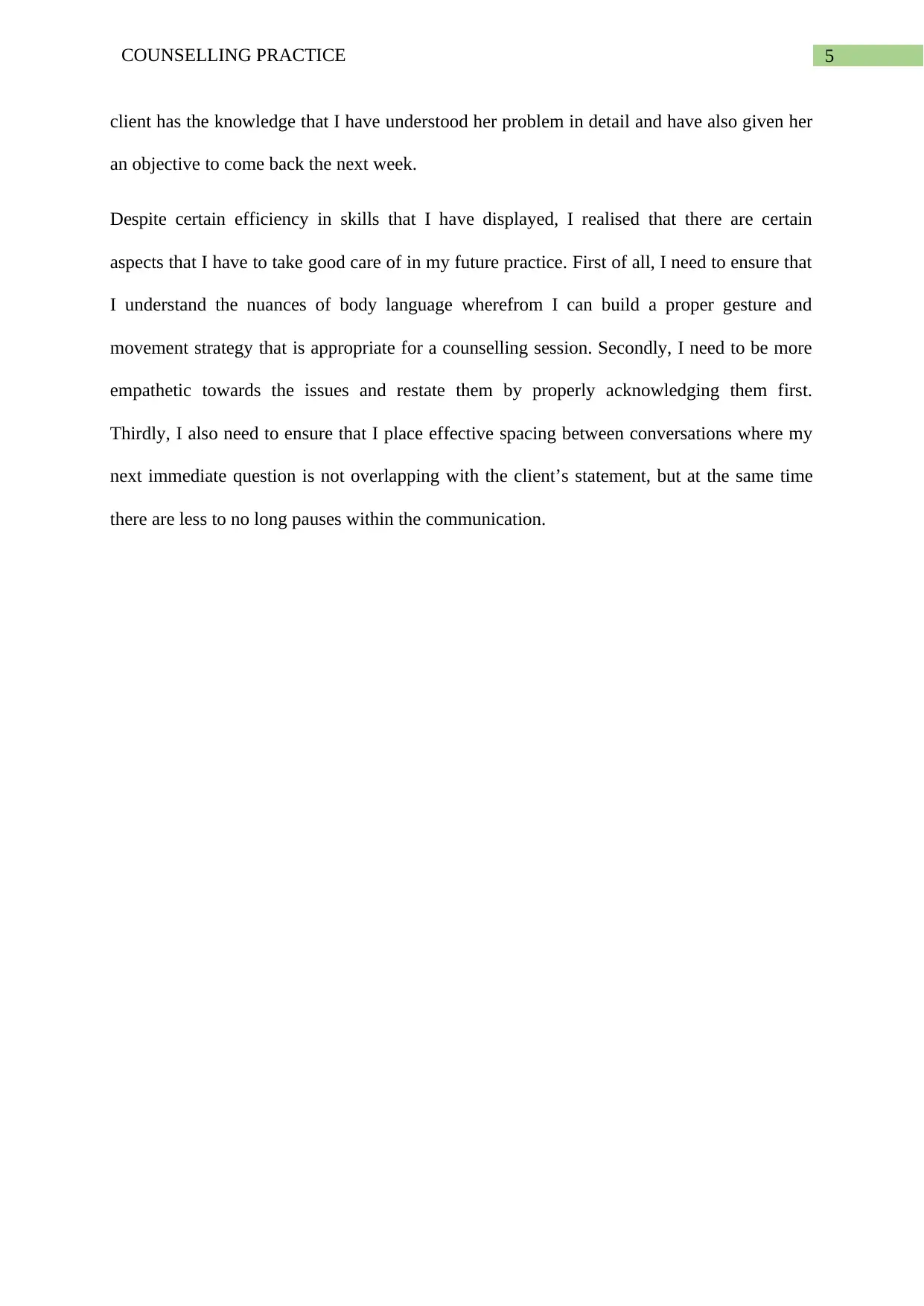
5COUNSELLING PRACTICE
client has the knowledge that I have understood her problem in detail and have also given her
an objective to come back the next week.
Despite certain efficiency in skills that I have displayed, I realised that there are certain
aspects that I have to take good care of in my future practice. First of all, I need to ensure that
I understand the nuances of body language wherefrom I can build a proper gesture and
movement strategy that is appropriate for a counselling session. Secondly, I need to be more
empathetic towards the issues and restate them by properly acknowledging them first.
Thirdly, I also need to ensure that I place effective spacing between conversations where my
next immediate question is not overlapping with the client’s statement, but at the same time
there are less to no long pauses within the communication.
client has the knowledge that I have understood her problem in detail and have also given her
an objective to come back the next week.
Despite certain efficiency in skills that I have displayed, I realised that there are certain
aspects that I have to take good care of in my future practice. First of all, I need to ensure that
I understand the nuances of body language wherefrom I can build a proper gesture and
movement strategy that is appropriate for a counselling session. Secondly, I need to be more
empathetic towards the issues and restate them by properly acknowledging them first.
Thirdly, I also need to ensure that I place effective spacing between conversations where my
next immediate question is not overlapping with the client’s statement, but at the same time
there are less to no long pauses within the communication.
⊘ This is a preview!⊘
Do you want full access?
Subscribe today to unlock all pages.

Trusted by 1+ million students worldwide

6COUNSELLING PRACTICE
References
Bond, T., & Mitchels, B. (2014). Confidentiality & Record Keeping in Counselling &
Psychotherapy. Sage.
Davis, D. M., & Hayes, J. A. (2011). What are the benefits of mindfulness? A practice review
of psychotherapy-related research. Psychotherapy, 48(2), 198.
De Stefano, J., Mann-Feder, V., & Gazzola, N. (2010). A qualitative study of client
experiences of working with novice counsellors. Counselling and Psychotherapy
Research, 10(2), 139-146.
Egan, G. (2018). The Skilled Helper: A client-centred approach. Cengage Learning EMEA.
Riggall, S. (2012). Social work students’ experiences of using the Egan Skilled Helper
model. The Journal of Practice Teaching and Learning, 11(1), 37-53.
Stickley, T. (2011). From SOLER to SURETY for effective non-verbal
communication. Nurse education in practice, 11(6), 395-398.
Strawbridge, S., & Woolfe, R. (2010). Counselling psychology: Origins, developments and
challenges. Handbook of counselling psychology, 3, 3-22.
Topuz, C., & Arasan, Z. (2014). Self-awareness group counseling model for prospective
counselors. Procedia-Social and Behavioral Sciences, 143, 638-642.
Trower, P., Jones, J., & Dryden, W. (2015). Cognitive behavioural counselling in action.
Sage.
References
Bond, T., & Mitchels, B. (2014). Confidentiality & Record Keeping in Counselling &
Psychotherapy. Sage.
Davis, D. M., & Hayes, J. A. (2011). What are the benefits of mindfulness? A practice review
of psychotherapy-related research. Psychotherapy, 48(2), 198.
De Stefano, J., Mann-Feder, V., & Gazzola, N. (2010). A qualitative study of client
experiences of working with novice counsellors. Counselling and Psychotherapy
Research, 10(2), 139-146.
Egan, G. (2018). The Skilled Helper: A client-centred approach. Cengage Learning EMEA.
Riggall, S. (2012). Social work students’ experiences of using the Egan Skilled Helper
model. The Journal of Practice Teaching and Learning, 11(1), 37-53.
Stickley, T. (2011). From SOLER to SURETY for effective non-verbal
communication. Nurse education in practice, 11(6), 395-398.
Strawbridge, S., & Woolfe, R. (2010). Counselling psychology: Origins, developments and
challenges. Handbook of counselling psychology, 3, 3-22.
Topuz, C., & Arasan, Z. (2014). Self-awareness group counseling model for prospective
counselors. Procedia-Social and Behavioral Sciences, 143, 638-642.
Trower, P., Jones, J., & Dryden, W. (2015). Cognitive behavioural counselling in action.
Sage.
1 out of 7
Related Documents
Your All-in-One AI-Powered Toolkit for Academic Success.
+13062052269
info@desklib.com
Available 24*7 on WhatsApp / Email
![[object Object]](/_next/static/media/star-bottom.7253800d.svg)
Unlock your academic potential
Copyright © 2020–2025 A2Z Services. All Rights Reserved. Developed and managed by ZUCOL.





